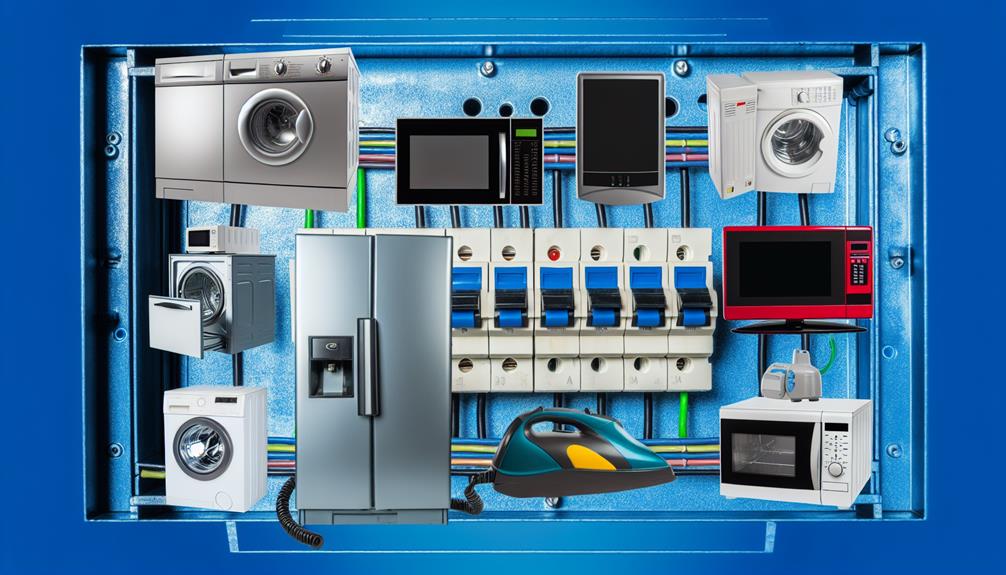How to Assess Your Home’s Electrical Service Needs
Coincidentally, you have just moved into a new home and are eager to ensure that its electrical service is up to par. But where do you begin?
Assessing your home’s electrical service needs is an important step in maintaining a safe and efficient living environment. By understanding the electrical load, evaluating your current setup, and identifying signs of overload, you can determine if any upgrades are necessary.
However, it’s crucial to consult with a professional electrician to ensure an accurate assessment.
So, are you ready to discover the key steps to assessing your home’s electrical service needs?
Key Takeaways
- Calculate the total electrical load by adding up the power requirements of all devices and appliances in your home.
- Conduct a visual inspection and test outlets with a voltage tester to assess the condition of your electrical setup.
- Signs of overload, such as tripping circuit breakers or flickering lights, should be addressed promptly by consulting a licensed electrician.
- Consider necessary upgrades like replacing outdated circuit breakers, upgrading wiring, and increasing the capacity of your electrical panel to ensure safety and meet modern electrical needs.
Understanding Your Electrical Load
To accurately assess your home’s electrical service needs, it’s crucial to have a clear understanding of your electrical load. Your electrical load refers to the amount of power that’s required to operate all the electrical devices and appliances in your home. It’s measured in watts or kilowatts and can vary depending on the size of your home and the number and type of electrical devices you have.
To determine your electrical load, you need to identify all the electrical devices and appliances in your home and calculate their power requirements. This can be done by checking the labels on the devices themselves or by referring to their user manuals. The power requirements are usually listed in watts or amps.
Once you have gathered this information, you can add up the power requirements of all your devices to determine your total electrical load. This will give you an idea of how much power your home consumes on a regular basis.
Understanding your electrical load is important because it helps you determine if your current electrical service is adequate or if you need to upgrade to a higher capacity service. It also helps you identify any potential issues such as overloaded circuits or outdated electrical systems.
Evaluating Your Current Electrical Setup
Assessing the effectiveness and safety of your current electrical setup is crucial in ensuring optimal functionality and preventing potential hazards. To evaluate your current electrical setup, follow these steps:
- Conduct a visual inspection: Look for any signs of wear and tear, such as frayed wires or damaged outlets. Check for loose connections and ensure that all electrical components are properly grounded.
- Test your outlets: Use a voltage tester to check if all the outlets are functioning correctly. Ensure that there are no loose or broken outlets and that the polarity is correct.
- Review your circuit breaker panel: Take a look at your circuit breaker panel and check if it’s properly labeled. Make sure that the breakers aren’t overloaded and that they trip when necessary. Consider upgrading to a modern circuit breaker panel if yours is outdated.
- Evaluate your electrical capacity: Determine if your current electrical setup can meet your household’s needs. Consider factors such as the number of appliances and devices you use, as well as any plans for future additions or renovations. If necessary, consult with an electrician to determine if an electrical service upgrade is required.
Identifying Signs of Overload
One way to evaluate the electrical capacity of your home is by identifying signs of overload. Overloading occurs when you have too many electrical devices connected to a circuit, exceeding its capacity. This can lead to overheating, electrical fires, and damage to your appliances. To determine if your home is experiencing an overload, there are several signs to look out for.
Firstly, if your circuit breakers frequently trip or fuses blow, it’s a clear indication of an overloaded circuit. These safety devices are designed to protect your home from electrical hazards by shutting off the power when there’s an excessive current flow. If they’re tripping or blowing frequently, it means that the circuit is being overloaded.
Secondly, if you notice flickering or dimming lights when you turn on certain appliances, it could be a sign of an overloaded circuit. When an appliance with a high power requirement is turned on, it can draw too much current, causing the voltage to drop and the lights to flicker or dim.
Lastly, if you experience frequent electrical shocks or tingling sensations when you touch an appliance or a switch, it could be due to an overloaded circuit. This happens when the circuit is unable to handle the electrical load, leading to improper grounding.
If you observe any of these signs, it’s important to take them seriously and address the issue promptly. Ignoring an overloaded circuit can result in serious damage and safety risks. Consider consulting a licensed electrician to evaluate your home’s electrical system and make any necessary upgrades to ensure its capacity meets your needs.
Determining Potential Upgrades
If you have identified signs of overload in your home’s electrical system, it’s essential to determine the potential upgrades that may be required. Upgrading the electrical service in your home can help prevent future issues and ensure the safety and functionality of your electrical system.
Here are four potential upgrades to consider:
- Service Panel Upgrade: The service panel is the control center of your electrical system, and if it’s outdated or unable to handle the electrical load, it may need to be upgraded to a larger capacity panel.
- Circuit Breaker Replacement: If your circuit breakers are constantly tripping or if they’re old and outdated, it may be necessary to replace them with newer models that can handle the electrical demand more efficiently.
- Wiring Upgrade: Older homes may have outdated wiring that isn’t capable of handling the electrical load of modern appliances and devices. Upgrading the wiring in your home can help prevent electrical issues and improve the overall safety of your electrical system.
- Additional Outlets: If you find that you’re constantly using power strips or extension cords to accommodate all of your electrical devices, it may be time to consider adding additional outlets throughout your home. This can help distribute the electrical load more evenly and reduce the risk of overloading circuits.
Consulting With a Professional Electrician
To ensure that your potential upgrades are properly implemented and to address any other electrical concerns, it is advisable to consult with a professional electrician who can provide expert guidance and recommendations. A professional electrician possesses the necessary knowledge and experience to assess your home’s electrical system and identify any issues or improvements that need to be made. They can also provide you with a detailed plan for upgrading your electrical service to meet your specific needs.
When consulting with a professional electrician, it is important to provide them with accurate information about your home, such as the size, layout, and age of your property. This will help them better understand your electrical service requirements and make appropriate recommendations. Additionally, it is essential to communicate your expectations and budget constraints to ensure that the proposed upgrades align with your goals and financial capabilities.
During the consultation, the electrician may conduct a thorough inspection of your electrical system, including the main electrical panel, circuits, outlets, and wiring. They may also evaluate the capacity of your current service and determine if additional circuits or a service upgrade is necessary. To help you understand the recommendations, here is a table summarizing the potential upgrades that may be suggested by a professional electrician:
| Potential Upgrade | Description |
|---|---|
| Circuit Installation | Adding new circuits to accommodate increased electrical load |
| Panel Upgrade | Replacing an outdated or insufficient electrical panel |
| Wiring Replacement | Upgrading old or faulty wiring for improved safety |
| Surge Protection System | Installing devices to protect against voltage spikes |







